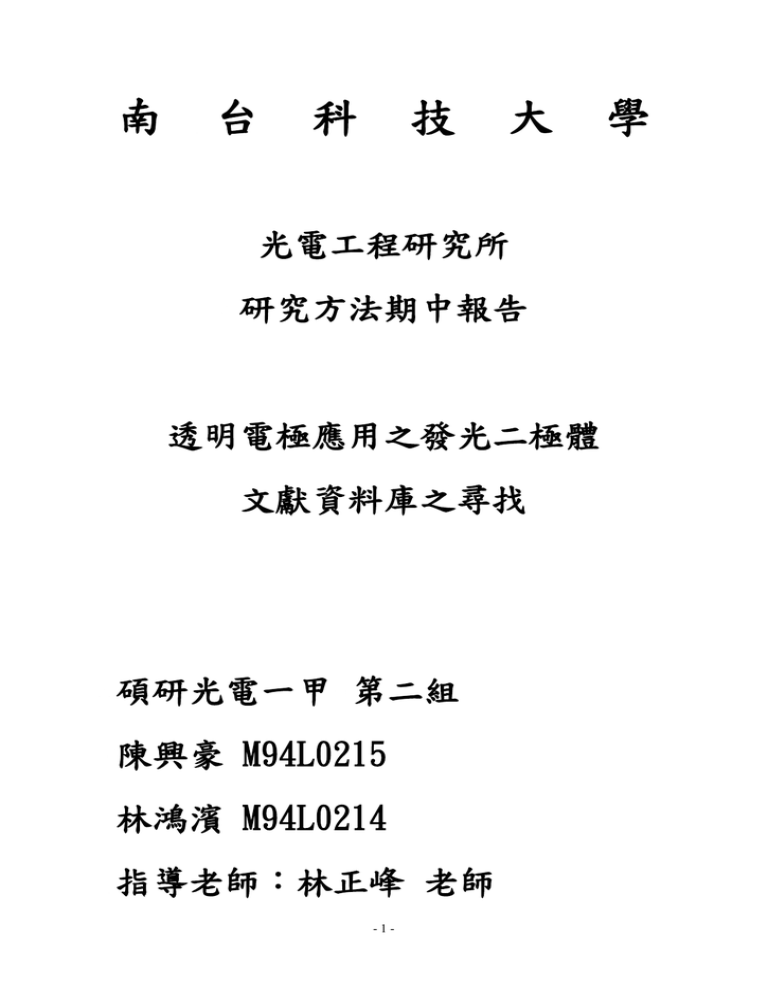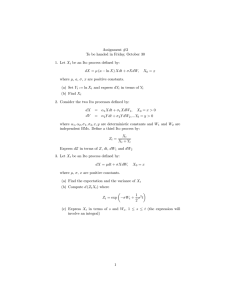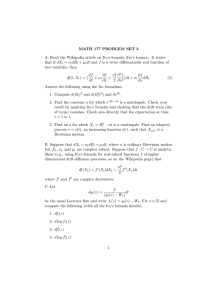
南
台
科
技
大
光電工程研究所
研究方法期中報告
透明電極應用之發光二極體
文獻資料庫之尋找
碩研光電一甲 第二組
陳興豪 M94L0215
林鴻濱 M94L0214
指導老師:林正峰 老師
-1-
學
中文資料庫
(1) 碩博士論文
文獻數目:共 9 篇
資料庫單位:全國博碩士論文資訊網(使用進階查詢)
網址:http://etds.ncl.edu.tw/theabs/index.jsp
關鍵字:透明電極 AND 發光二極體
第一頁第一筆:
論文名稱:透明電極應用於 III-V 發光元件之研究
[摘要]
本論文主要研究透明電極氧化銦錫(ITO)之製作與其特性,並應用在三五族發光
元件,以改善其元件特性。論文中將 ITO 作為視窗層(window layer)與電流擴散
層(current-spreading layer)應用在晶片黏貼之鏡面基板的磷化鋁銦鎵發光二
極體 (AlGaInP/mirror/Si MS LED)與氮化鎵發光二極體。藉控制製程參數之氧
化銦錫薄膜具有低的電阻率(2.1´10-4Ω-cm)與高穿透率(可見光範圍>90%)。在
MS LED 之應用方面在其表面鍍上 ITO 可有效提昇光的輸出。當注入電流增加,
此元件也可以表現出光的均勻分布且不會有發光飽和現象的光輸出線性增加。此
外,鏡面基板發光二極體,銦錫氧化物/鏡面基板發光二極體,銦錫氧化物/銦/
鏡面基板發光二極體,在外部功率效率比原始相同吸光基板的發光二極體分別增
加了 2.8,3.0 及 3.4 倍。此可歸因於加入一層銦降低了銦錫氧化物與砷化鎵接
觸層之接觸電阻,且對發出的光並不會造成明顯的吸收。此實驗中,銦錫氧化物
/銦/鏡面基板發光二極體可以得到最高的功率轉換效率。
在寬能隙半導體氮化鎵之應用方面,當銦錫氧化物直接接觸到氮化鎵雖然無法達
到歐姆接觸,但是在接面加入一適當的極薄金屬層並作適當的退火處理便可以得
到特性良好的歐姆接觸。此外,此方法可以顯著的降低接觸電阻並且不會影響光
的穿透。以銦/銦錫氧化物(30 nm/250 nm)接觸到 n 型氮化鎵(1´1018 cm-3)在
600oC 熱處理之後,其特徵接觸電阻率為 6.9´10-4 W-cm2 ,可見光的穿透率為
80% 至 95%。此外,以鎳/銦錫氧化物(10 nm/250 nm) 接觸到 p 型氮化鎵 (2´1017
cm-3) 在空氣中經 600oC 熱處理之後,其特徵接觸電阻率為 8.6´10-4 W-cm2 ,
在波長為 450 至 550 nm 光的穿透率大於 80% 。論文中將會討論造成此低接觸
-2-
電阻與高穿透率可能的機制。此種方法與製程可以使用在高效率的氮化鎵發光元
件上。
第一頁第二筆:
論文名稱: ITO 性質探討與氮化鎵發光二極體之應用
[摘要]
本研究目的,即利用濺鍍法製備高品質、高穿透率與高導電性的 ITO 透明導電
膜。並改變其中濺鍍條件(氣體、壓力)…等,吾人發現對於薄膜光學性質,電性
有著很大的影響。ITO 經氧氣熱處理其結晶性有改善的趨勢,並由研究發現當鍍
膜時通入氧氣流量增加時,其電阻率上升且達一飽和值,可能原因為 In2O3:SnO2
之濺鍍源成份與基板附近氧氣碰撞進而反應之機率增加,使薄膜內氧缺位態減
少,並且較多之 SnO2 形成使 Sn4+取代 In3+之機會降低,因此電阻率漸增並達到
ㄧ飽和值
-cm)。另 一方面,於純 Ar 氣氛或微量氧含量下(< 1%)濺鍍時,
ITO 電阻率明顯下降,此時可能因濺鍍過程中 ITO 成份中氧原子的分解,且外界
並無提供氧氣彌補氧的缺陷,因此形成很多氧空缺,使得此時 ITO 有最低的電阻
率。
第一頁第三筆:
論文名稱:電子槍蒸鍍氧化銦錫薄膜在 AlGaInP 發光二極體應用之研究
[摘要]
氧化銦錫(Indium-Tin Oxide, ITO)對可見光具高度透明度及電傳導性,常當做
一個透明電極 ,被廣泛地使用在發光元件上。在本研究中,使用快速熱退火(RTA)
的熱處理方式,並以圖一的元件結構,來探討 ITO 經熱處理後對 AlGaInP 紅光二
極體的影響。
首先,我們用電子束個別蒸鍍兩種不同比例(In2O3/SnO2=90/10 or 95/5)ITO 於
p+-GaAs 基板、半絕緣 GaAs 基板與玻璃上,並以快速熱退火分別通入氮氣(N2)
及氫氣(H2)做熱處理,通入 H2 做熱處理的 ITO 薄膜,從特徵接觸電阻與霍爾量
測,顯示具有較低的特徵接觸電阻與片電阻,但是透光度卻相當差;而以 N2 做
熱處理的 ITO 薄膜經由最佳的熱處理會有較高的氧含量,並因為 N2 的導入 ITO
內導致高的透光度(>90%)。此外,ITO 蒸鍍靶材成分的不同也影響其光和電的
特性,我們發現 ITO(In/Sn=90/10)經過熱處理有較好的電特性而
ITO(In/Sn=95/5)有較好的光特性。
在 ITO 薄膜的光電特性量測之後,蒸鍍 ITO 在 AlGaInP 紅光二
極體上當作電流分散層(current spreading layer)及優良的光取出界面。由於
-3-
ITO 與 GaAs 的低特徵阻值(約 1~5×10-4Ω-cm2)和在可見光光譜範圍的高穿透率
被成功地應用在 LED 的製作上。我們發現有加 ITO 的 LED 有較好的 I-V 特性和較
小的半高波寬,此外當 ITO 厚度為 50nm 在氮氣中(N2)及溫度 400oC 以上回火可
以得到比一般沒加 ITO 的 LED 更高的光輸出功率,確信能改善目前在市場上之發
光二極體。
第一頁第 8 筆:
論文名稱:硫化處理對 P 型氮化鎵與透明電極歐姆接觸特性之研究
[摘要]
本篇論文中,我們利用硫化的方法對 P 型氮化鎵進行表面處理,並且以電子槍蒸
鍍機蒸鍍鎳/金薄金屬於 P 型氮化鎵上,金屬膜厚度為 25Å/25 Å。接著於空氣的
環境下,將試片以 500℃進行熱處理,結果可以得到良好的歐姆接觸特性,以及
低特徵電阻值達 10-6Ωcm2 這個級數。
由於傳統金屬電極有遮光,與電流無法均勻擴散等缺點,我們希望以銦錫氧化膜
的高穿透率,以及高導電性等特性來克服傳統電極的缺點。然而因為銦錫氧化膜
為 N 型半導體材料,所以與 P 型氮化鎵接觸時有 P-N 接面的問題,我們便設計新
電極結構來改善上述問題。另外我們也以穿透率光譜觀察薄膜在發光中心波長為
470nm 的穿透率,鎳/金薄金屬在含氧環境下熱處理後,穿透率可達 90﹪以上;
而新結構的電極在熱處理後,穿透率約在 80﹪。
我們除了電流-電壓特性的量測外,也利用原子力顯微鏡觀察硫化處理對 P 型氮
化鎵表面粗糙度的影響,以及薄金屬在熱處理前後的分佈情形。實驗結果發現經
過硫化處理的氮化鎵試片表面粗糙度明顯降低;蒸鍍鎳/金薄金屬於硫化處理之
P 型氮化鎵後也同樣有較佳之平整度;試片進一步的熱處理,發現經過硫化處理
之 P 型氮化鎵表面的薄金屬呈現一個較平整且連續的分佈情形。
另外在實驗過程中,我們發現試片在熱處理時,有水汽的加入不會導致鎳/金金
屬膜與 P 型氮化鎵的接觸特性變差,但是有水汽加入熱處理製程的試片,其表面
的金屬分佈呈現一個較不均勻的結果,並且進而影響元件特性。
第一頁第 10 筆:
論文名稱:氮化鎵藍色發光二極體透明電極之製作與研究
[摘要]
在本篇論文中,我們利用電子槍蒸鍍機,蒸鍍非常薄的鎳/金雙層金屬電極在 p
型氮化鎵上,在不同的條件下做熱處理,完成歐姆接觸,實驗結果發現,當金屬
厚度為 25 Å/50 Å,在空氣環境下 450oC 熱處理,特徵接觸電阻值為 8.2
-4-
×10-4Ωcm2,利用氧化的方式,可以使鎳氧化成氧化鎳,有助於歐姆接觸的形成,
且氧化鎳可提升穿透率,在 470nm,穿透率可提升至 73﹪。將上述薄膜應用在氮
化鎵發光二極體上,在順向偏壓,電流為 20mA 時,Vf 為 3.45 伏特,發光波長
為 470nm,半高寬為 34nm,發光強度為 0.65mW。
由於薄金屬電極有遮光,及電流不易均勻擴散等缺點,因此我們也研究銦錫氧化
膜與 p 型氮化鎵的接觸,但因為銦錫氧化膜為一 n 型半導體材料,不易形成歐姆
接觸,所以我們亦嘗試加入薄金屬改善其接觸特性。
第一頁第 14 筆:
論文名稱:氧化銦錫透明電極應用於氮化鎵發光二極體
[摘要]
本論文利用射頻磁控濺鍍法濺鍍氧化銦錫透明導電薄膜分別於石英玻璃與 p 型
氮化鎵之上,首先濺鍍於石英玻璃上探討製程參數對 ITO 導電薄膜的光學特性以
及電學性質的影響;其後將 ITO 濺鍍在 p 型氮化鎵上研究透明導電薄膜與半導體
間的接觸特性,最後用於發光二極體元件上對於元件特性作一分析。
從實驗中發現在室溫下所濺鍍出的氧化銦錫導電薄膜,利用快速熱退火處理在氮
氣環境下可以有效的降低片電阻值,並且在 600oC 退火時間 30 秒時得到最低的
片電阻值為 12.18Ω/□且在藍光區透光度為 80%以上。並且從 XRD 的分析上得
到在氮氣環境下退火氧化銦錫薄膜從非晶結構到以(222)方向為擇優取向,而
氧氣環境下退火則發現薄膜呈現(400)方向為擇優取向。再與薄膜的電學特性
作比較發現以此方法濺鍍出的 ITO 薄膜(222)的結晶方向較有利於載子的傳導
因此有較佳的電阻值。並且在霍爾量測的結果得到氮氣環境下退火的薄膜可以有
效的活化內部的載子以此做一印證。並且從穿透光譜所量測出來的結果發現退火
中所使用的氣體,使用氮氣的比例含量提高則穿透光譜的峰值有往短波長移動的
趨勢。
而使用 NiO 作為 ITO 與 P 型氮化鎵接觸的介層,在氧氣環境下退火 550oC30 秒所
得到的特性接觸電阻將有效的改善至 2.26 x10-3 Ω-cm2,而在製程上應用至氮
化鎵發光二極體得到啟動電壓為 3.28V 與阻值為 47.8Ω,並且發光二極體的發光
強度提升的 50%。
第二頁第 20 筆:
論文名稱:氮化鈦薄膜應用於發光二極體透明電極之研究
[摘要]
一般的 AlGaInP 發光二極體都是成長在 n-型 GaAs 基板上,電流自上面流下經過
-5-
p 層然後至活性層以產生光,為了要得到高發光效率,p 層的電流分佈非常重要。
為了促進電流分佈以提高發光二極體的發光效率,一法為成長一層厚的 GaP 窗口
層在最上面,但因為以有機金屬氣相沈積法不易成長足夠厚度且高品質之 GaP
窗口層,因此另一法為成長透明導電薄層,即本論文提出之氮化鈦透明導電膜。
本論文利用真空濺鍍系統在 AlGaInP 發光二極體上沈積氮化鈦薄膜(約 50nm)來
作為透明電極。同時也將氮化鈦沈積在透明基材上,以研究薄膜之光穿透率。回
火前氮化鈦薄膜沈積在透明基材上於可見光範圍透光率可至 60%,回火後透光率
下降;回火後氮化鈦薄膜沈積於 GaP 上電阻率可至 850μΩ-cm,較回火前電阻
率為低。
氮化鈦沈積在 p 型磷化鎵上呈現整流特性。為了同時兼顧氮化鈦的光特性及電特
性,乃嘗試先沈積一層鈦當作緩衝層以提升氮化鈦的薄膜品質。如預期的電流有
明顯的增加,發光二極體的臨界電壓(在 20mA 時)也明顯下降。
第二頁第 26 筆:
論文名稱:IZO 透明金屬薄膜之研製及其在 GaN 基 LEDs 之應用研究
[摘要]
新穎透明導電材料─銦鋅氧化物(Indium-Zinc-Oxide,IZO)─是近年來在學術界
被熱烈研究的一種化合物半導體電極材料。由於 IZO 薄膜具有高穿透率、低電阻
率、以及均勻的蝕刻性,因此非常適合應用於光電元件,例如各種平面顯示器的
透明電極、發光二極體的透明導電層、太陽能電池、光電偵測器等,深具應用發
展潛力。
於本研究中,我們係利用 RF 濺鍍法成長 IZO 薄膜,並針對所得薄膜進行光、電
特性量測與分析。藉由濺鍍參數之調變,所得室溫下之最佳電阻率為
3.69�e10-4 �-cm2,於可見光區域內(400-800nm)平均穿透率為 80%以上。IZO
薄膜經霍爾(Hall)量測顯示係為一 n 型高濃度材料。我們亦嘗試將 IZO 膜在氮氣
或氧氣環境下進行熱處理,實驗結果顯示 3000Å 厚度的 IZO 薄膜於藍光波長區間
具有 92%的穿透率,經氧氣環境下熱處理後 IZO 之電阻率會大幅提高,並據原子
力顯微鏡 AFM 測得其表面粗糙度亦呈現大幅增加,而穿透率之波峰於頻譜上則顯
現出紅移位現象。
於應用方面,本論文旨在利用 IZO 薄膜作為 GaN 基 LEDs 之透明導電層(TCL)以增
加發光效率。我們分析 IZO/p-GaN 之接觸特性,實驗結果顯示其為蕭基接觸。於
使用一薄金(45Å)/鎳(25Å)以及鎳(50Å)作為 IZO 與 p-GaN 間之披覆層並以熱處理
方式來改善其接觸特性,實驗結果發現若先將金/鎳/p-GaN 適當氧化再於其上成
長 IZO 膜,將可獲得良好的歐姆接觸特性。
於 GaN 基發光二極體之實作方面,與傳統金鎳製程比較,本論文所提以
-6-
IZO(3000Å)/氧化-金(45 埃 Å)/鎳(25Å)/p-GaN 之製程,於 20mA 導通電流條件
下,據 L-I 特性分析其光輸出功率增加 30%;另據 I-V 特性分析,順向電壓則增
加 0.5 伏特;而據�d-I 特性分析,採用 IZO 薄膜後元件之主波長�d 於藍光區
間發生紅移效應。
第二頁第 27 筆:
論文名稱:透明導電膜氮化鈦於發光二極體上之分析與研究
[摘要]
AlGaInP 發光二極體大多是成長在 n-型 GaAs 基板上,電流自 p 層由上而下至主
動層以產生光。要得到高發光效率,p 層的電流分佈非常重要。為了促進電流分
佈以提高發光二極體的發光效率,本論文試著沉積一層氮化鈦薄膜,並藉由不錯
的熱穩定性與散熱作用,達到在高發光效率時有更佳之電流分布作用。
本論文利用真空濺鍍系統在 AlGaInP 發光二極體上沈積氮化鈦薄膜來作為透明
電極。並以 XRD、AES、XPS 為分析的主軸,試著從材料分析的角度探討含氧量與
結晶性對於氮化鈦薄膜品質的影響。氮化鈦沈積在 p-型磷化鎵上呈現整流特
性。因此嘗試先沈積一層鈦當作緩衝層以提升氮化鈦的薄膜品質,並可同時兼顧
氮化鈦的光特性及電特性。如預期的發光二極體的臨界電壓(在 20mA 時)有明顯
下降,且電流分佈也有增加的趨勢。
(2) 學術會議論文
文獻數目:共一篇
資料庫單位:全國科技資訊網路 STICNET
網址:http://sticnet.stpi.org.tw/sticweb/html/
關鍵字:透明電極
第一頁第一筆
論文名稱:
銦錫氧化物透明電極對有機發光二極體元件光電特性及效能之影響
[摘要]
-7-
本文主要為探討銦錫氧化物(Indium tin oxide)透明導電膜本質之功函數、表面粗糙度以及與有機
材料層界面情況對有機發光二極體(OLED)元件效能之影響。藉著氧電漿(O/sub 2/-Plasma)、化學
機械研磨(Chemical mechanical polish, CMP)以及加入電洞注入層-銅菁(CuPc)有機材料等方式處
理 ITO,進而了解各種方式對元件的影響。本研究所得之具體結果顯示出:(1) O/sub 2/-Plasma
能有效的提高 ITO 之功函數以及清除表面污染物,提高電洞注入的能力,進而使得元件亮度以
及效率提昇。(2) O/sub 2/-Plasma 雖然有助於使得 ITO 表面平坦化以及降低漏電流,但平坦化的
程度有限,因而漏電流只能降低至某一範圍。(3) CMP 能有效的降低 ITO 之表面粗糙度(Ra=3A),
藉由表面粗糙度的降低,漏電流可降至 1*10/sup -6/(mA/cm/sup 2/)左右。若 ITO 經 CMP 後再經
O/sub 2/-Plasma 處理,元件之漏電流反而會提昇。(4) ITO 經 CMP 後可提升元件效率,且元件效
能與 ITO 成長溫度並無太大關係。(5) CuPc 能提昇元件的效率及亮度,且具有降低漏電流的作
用。
(3) 期刊論文
文獻數目:共一篇(有提供摘要的)
資料庫單位:中華民國期刊論文索引 (詳細查詢)
網址: http://163.26.236.4/ncl3web/default.htm
關鍵字:ITO
第 30 筆
論文名稱:.應用於平面顯示器之 ITO 透明電極
本篇文章中將介紹 ITO (Indium Tin Qxide)透明電極之物理特性,導電機制,
製作方法以及就影響其特性之製程參數做討論。 對 ITO 膜特性之要求也將做描
述。對於廣泛 使用於製造 ITO 膜之濺鍍法 (Sputtering),文中有基礎性的介
紹。最後針對製程參數方面 ,將分別探討溫度,放電電壓,氣體相成及靶材材
料等對 ITO 膜特性之影響。 藉由本文希 望能給予讀者有關 ITO 薄膜電極的基
本概念。
-8-
西文資料庫
(1)
Ei Engineering Village2 (EV2){Quick search}
文獻數目:37 篇
關鍵字:transparent AND electrode AND LED
例如:
論文名稱:InGaN-based light-emitting diodes fabricated with transparent
Ga-doped ZnO as ohmic p-contact
Abstract: Ga-doped ZnO (ZnO: Ga) was fabricated by molecular-beam epitaxy to
employ as highly transparent contact electrode on p-GaN layer. ZnO:Ga films have
higher transparency in near uv and blue wavelength range than the conventional
Ni/Au oxidized alloy p-electrode. The as-deposited ZnO:Gap-electrodes worked as
ohmic contacts for the p-GaN layers without any kind of post annealing processes.
The optical power of InGaN light-emitting diode (LED) fabricated with ZnO: Ga
-9-
p-contact was doubled compared to that with Ni/Au p-electrode. The LED chips with
ZnO: Ga were operated at forward current of 20 mA in the environment of
temperature of 121°C, humidity of 85%, and pressure of 1.6 atm. The tested LED has
lifetime of 80 and more hours in this environment. © 2004 WILEY-VCH Verlag
GmbH and Co. KGaA, Weinhim. (16 refs.)
論文名稱:GaN-based light-emitting diodes with Ni/AuBe transparent
conductive layer
Abstract: Ni/AuBe as p-type ohmic contact to p-GaN in the heat treatment process are reported.
By selection of an optimum condition, the best construction of Ni/AuBe bi-layers is 5 nm/5 nm thick. The
light-transmission is about 75% for 470 nm blue light and the lowest specific contact resistance obtained
is 2 × 10-3 Ωcm2 examined by transmission line model after heat treatment process at 500 °C alloying
temperature during 10 min in nitrogen ambient. The Be atom may plays an important role in the formation
of good ohmic contacts. On the other hand, Ni/AuBe bi-layers are also applied to GaN-based
light-emitting diodes (LEDs) as p-type ohmic contact electrode. The typical I-V characteristics of the
GaN-based LEDs with 5 nm/5 nm-thick Ni/AuBe TCL exhibit a forward-bias voltage of 3.41 V at injection
current of 20 mA. © 2003 Elsevier Ltd. All rights reserved.
- 10 -
(16 refs.)
關鍵字:transparent AND conductor AND OLED
日期:(2000~2005 年)
語言:(英文)
文獻數目:共 7 篇
第一頁第一筆
論文名稱: Inverted top-emitting organic light-emitting
diodes using transparent conductive NiO electrode
[摘要]
We report on a top-emitting organic light-emitting device
(TE-OLED) using a thermally evaporated and semi-transparent
NiO film as a top-electrode. Our TE-OLED was fabricated,
basically taking the reverse sequence for the fabrication of a
conventional bottom-emitting organic light-emitting device
(BE-OLED). Since the resultant sheet resistance of our NiO was
high (8 kΩ/ [Square Open] ) and its transmittance was only 50%,
the resulting luminance ( [similar to] 150 cd/m2) and injection
current ( [similar to] 50 mA/cm2) of our TE-OLED were much
inferior to those of the BE-OLED device. However, its
top-emitting was clearly observable and is thus concluded
that our TE-OLED using thermally evaporated NiO, is quite
promising if the NiO is controlled to have lower sheet
resistance than the present value. © 2004 Elsevier B.V. All
rights reserved. (9 refs.)
第一頁第 2 筆
論文名稱: Highly flexible transparent electrodes for
organic light-emitting diode-based displays
- 11 -
[摘要]
Multilayer indium-tin-oxide (ITO)-Ag-ITO stacks were
evaluated as transparent conductors for flexible organic
light-emitting diode (OLED) displays. The ITO-metal-ITO (IMI)
samples exhibited significantly reduced sheet resistance over
ITO and greater than 80% optical transmission. The IMI films
deposited on plastic substrates showed dramatically improved
mechanical properties when subjected to bending both as a
function of radius of curvature as well as number of cycles to a
fixed radius. OLEDs were fabricated on both ITO and IMI anodes,
and the devices with IMI anodes showed improved performance
at current densities greater than 1 mA/cm2 due to the improved
conductivity of the anode. © 2004 American Institute of Physics.
(18 refs.)
第一頁第 5 筆
論文名稱: Optical and electrical properties of Cr-SiO
thin films for flat panel displays
[摘要]
Low temperature fabrication of transparent conducting
materials is a key issue in flat panel display production.
Though Cr-SiO cermet thin films have predominantly been used
as thin film resistors in a variety of microelectronics
applications, it is shown in this paper that the material can
successfully be used as a transparent to semi-transparent
conductor in some applications if the value of the extinction
coefficient, k, can be kept low ( less than or equal 0.3). Thus, a
detailed study of the interdependence of the resistivity and
optical properties of Cr-SiO is presented for the first time
within the context of its use in the flat panel display industry.
Specifically, Cr-SiO can be employed as part of Luxell's
optical interference structure, known as the Black Layer
[trademark] , US patent 5,049,780, used to increase contrast in
- 12 -
TFEL and OLED displays.
第一頁第 6 筆
論文名稱: Criteria for ITO (indium-tin-oxide) thin film
as the bottom electrode of an organic light emitting
diode
[摘要]
TCO (transparent conductive oxide) thin films such as ITO
(indium tin oxide) have important roles in fabrication of OLED
(organic light emitting diode) displays. Although ITO is the
most widely used transparent conductor in the field of FPD
(flat panel display) industry, there are some unique
requirements from the viewpoint of OLED, which is different
from other display devices such as LCD (liquid crystal display)
and PDP (plasma display panel). Especially surface roughness
and work function are very important to enhance the stability
and efficiency of OLED. Because all functional organic layers
which act as injection, transportation and emission layers are
deposited on ITO, surface morphology of ITO is directly
transferred to them and uneven interface is not desirable for
the efficiency and stability of OLED. On the other hand, there
are several different terminologies - Ra (average roughness),
Rr.m.s. (root-mean-square roughness) and Rpv (peak to valley
roughness) - which are used to interpret the surface roughness,
are now all used altogether. In this work, we tried to define
which parameter is the most suitable to characterize ITO for
OLED and to explain the relationship between surface and I-V
characteristics of OLED. To characterize the effect of surface
morphology of the ITO electrode, light emitting diodes were
fabricated using various types of ITO films which have
different surface morphology and their dynamic
characteristics were compared. © 2002 Elsevier Science B.V. All
rights reserved. (6 refs.)
- 13 -
(2)
SCI(Science Citation Index)
文獻數目:17 篇
關鍵字:transparent AND conductive AND LED
第一頁第 9 筆
論文名稱:Frontier of transparent oxide semiconductors
[摘要]
Recent advancements of transparent oxide semiconductors (TOS) toward new
frontiers of "oxide electronics" are reviewed based on our efforts, categorized
as "novel functional materials", "heteroepitaxial growth techniques", and
"device fabrications". Topics focused in this paper are: (1) highly conductive
ITO thin film with atomically flat surface, (2) p-type TOS material ZnRh2O4, (3)
- 14 -
deep-ultraviolet (DUV) transparent conductive oxide beta-Ga2O3 thin film, (4)
electrochromic oxyfuolide NbO2F, (5) single-crystalline films of
InGaO3(ZnO)(m) grown by reactive solid-phase epitaxy, (6) p-type
semiconductor LaCuOS/Se epitaxial films capable of emitting UV- and
purple-light, (7) p-n homojunction based on bipolar CuInO2, (8) transparent
FET based on single-crystalline InGaO3(ZnO)(5) films, and (9) UV-light
emitting diode based on p-n heterojunction. (C) 2003 Elsevier Ltd. All rights
reserved.
第一頁第 10 筆
論文名稱:Transport properties of structures
containing a-Si : H : Er
[摘要]
The I-V characteristics of diode structures containing sputtered a-Si:H:Er films
for potential LED applications have been studied. The a-Si:H:Er films were
deposited on p(+) Si substrates. On top of the film, ZnO:AI transparent
conductive layers, 3 mm in diameter, were deposited. The back contacts were
made of AI. The Er concentration in the films was varied between 0.05 and
0.16 at%, and the hydrogen concentration between 14 and 24 at%. It was
found that the log-log plot of the forward I-V characteristic of a typical sample
consisted of several regions with different slopes. On the basis of models put
forward in the literature, it is proposed that the electron transport in the studied
structure is governed by unipolar carrier injection, and the space charge limited
currents are controlled by two types of electron trap. The first are probably
deep acceptor traps formed by dangling bonds, and the second are donor-like
levels created by Er-O complexes. The energy positions of these traps are
estimated. (C) 2003 Kluwer Academic Publishers.
第 2 頁第 11 筆
論文名稱:High-brightness inverted InGaN-GaN
multiple-quantum-well light-emitting diodes without a
- 15 -
transparent conductive layer
[摘要]
Unlike the conventional, layer structure of an InGaN-GaN
multiple-quantum-well light-emitting diode (LED), an LED with reversed p-type
and n-type layer sequence, and an n+/p+ tunnel junction has been
investigated. When operated at 20 mA, the output power of the inverted LED is
almost twice that of the conventional LED. Since the structures of these two
LEDs are alike when analyzed by X-ray diffraction, the improvement in the light
intensity could be attributed to the elimination of the absorption/reflection by
the transparent conductive layer and/or some quality improvement of p-type
GaN in the inverted LED.
第 2 頁第 16 筆
論文名稱:Diode structures based on p-GaN for
optoelectronic applications in the near-ultraviolet
range of the spectrum
[摘要]
It was previously reported that spectrally matched n-SiC and n-GaN-based
MIS Schottky barrier diode structures exhibited optical emission and
photosensitivity in the near-ultraviolet (UV) range of the spectrum and
rectification at elevated temperatures. However, such structures were not
practical due to the low mechanical and thermal stability of the
semitransparent Au contacts. In addition, we experienced difficulties in
achieving stable optical emission from the n-GaN-based structures. In this
work various Schottky barrier diode structures based on p-type GaN layers
grown on sapphire with silicon (Si), boron nitride (BN), and silicon dioxide
(SiO2) interfacial layers were investigated. Blue and wide-spectrum optical
emissions at forward and reverse bias, respectively, and photosensitivity were
observed from these structures. A spectral match in the range of 365-400 nm
between the light emitting diode (LED) and photodetector structures fabricated
on the same substrate was achieved. A total Lambertian radiant UV power of
similar to 466 muW was measured from a blue/UV LED at 22 V.
- 16 -
UV-transparent and electrically conductive SnOx layers were fabricated,
characterized, and employed for fabrication of p-GaN-based photodiode
structures. (C) 2000 American Vacuum Society. [S0734-211X(00)17906-5].
第 2 頁第 17 筆
論文名稱:Current injection emission from a transparent
p-n junction composed of p-SrCu2O2/n-ZnO
[摘要]
An ultraviolet light-emitting diode (LED) operating at room temperature was
realized using a p-n heterojunction composed of transparent conductive oxides,
p-SrCu2O2 and n-ZnO. Multilayered films prepared by a pulsed-laser
deposition technique were processed by conventional photolithography with
the aid of reactive ion etching to fabricate the LED device. A rather sharp
emission band centered at 382 nm was generated when a forward bias voltage
exceeding the turn-on voltage of 3 V was applied to the junction. The emission
may be attributed to a transition associated with the electron-hole plasma of
ZnO. (C) 2000 American Institute of Physics. [S0003-6951(00)02630-9].
- 17 -
(3)期刊/雜誌
文獻數目:63 篇
關鍵字:transparent and LED
日期:(2000~2005 年)
語言:(英文)
第一頁/74 筆
論文名稱:
Transparent conducting films and their influence on the
performance of organic LEDs
[摘要]
Tin-doped indium-oxide (ITO) and Al-doped zinc oxide (AZO) films were
fabricated by reactive evaporation and rf magnetron sputtering. The average
- 18 -
optical transmittance (λ: 400–800nm) reached 95% and the sheet resistance
was as low as 30Ω/ . Organic light-emitting devices (LEDs) were fabricated
with ITO and AZO transparent films as anode and poly (1,4-phenylene
vinylene) (PPV) or tris(8-hydroxyquinoline) aluminum (Alq3) as luminescence
layer. EL and PL spectra, current–voltage and brightness–voltage data were
analyzed. It is revealed that the turn-on voltage of the devices was less than
20V and the carrier injection was consistent with the tunneling theory.
Degradation of current with time at a given external voltage was obtained and
discussed.
第一頁/51 筆
論文名稱: Nitride-based near-ultraviolet LEDs with an ITO transparent
contact
[摘要]
Indium tin oxide (ITO) (2300nm) and Ni (5nm)/Au (10nm) films were deposited
onto glass substrates, p-GaN layers, n+-InGaN/GaN short-period-superlattice
(SPS) structures and near-ultraviolet (near-UV) In0.05Ga0.95N/Al0.1Ga0.9N light
emitting diodes (LEDs). It was found that ITO on n+-SPS structure could
provide us an extremely high transparency (i.e. 86.5% at 400nm) and a
reasonably small 1.2×10−3Ωcm2 specific contact resistance. It was also found
that, at 20mA, the forward voltage of the near-UV LED with ITO on n+-SPS
upper contact was 3.13V, which is exactly the same as that of the near-UV
LED with Ni/Au on n+-SPS upper contact. Furthermore, it was found that we
could achieve a 36% larger output power by using such an ITO on n +-SPS
upper contact.
資料庫尋找心得:
這次的報告讓我學習到許多搜尋資料的方法,比起直接
- 19 -
在網路上搜尋資料,上學校的資料庫尋找顯的比較方便而且
更有效率多了,不論是中文的 paper,還是西文的 paper 都顯
的比直接在搜尋引擎(Google) 上直接搜尋來的快而且更容
易找到符合的相關 paper,雖然 SCI 的資料庫要到成大去找,
但是也可以增加自己找 paper 的經驗,尤其是關鍵字的應用,
關鍵字在搜尋的時候是蠻重要的,有時候關鍵字如果用的不
太適合,通常比較不容易找到自己想要的,還有如果多打ㄧ
各關鍵字和少打ㄧ各關鍵字會影響到搜尋 paper 的篇數,再
來就是摘要的部份,摘要關於一篇 paper 的內容,是很重要的,
以關鍵字搜尋到資料之後,還要看摘要的內容是不是我們所
想要的.所以一開始剛開始找時找到的資料都一大堆無相關
的,慢慢的使用較多的邏輯運算子才能夠縮小範圍在經過篩
選後才能找到相關的。其中又以期刊論文以及學術會議論文
最為難找,要找到本來的 paper 就不多又要屬於相關的就真
的很少了,所以我們才找到期刊論文以及學術會議論文各一
篇,沒想到其他組也有跟我們同樣的情形,不過說到 SCI 與
EI 的不同在我們搜尋的過程中我們發現 SCI 的資料比 EI 的
多,對於作者、出處國家甚至連作者聯絡的 e-mail 都,比 EI
交代的更清楚明白,其中 EI 的搜尋又分為快速檢索、簡易檢
- 20 -
索、專家檢索幾種模式,而 SCI 檢索模式就沒有 EI 這麼多其
實我們在分別在 EI 及 SCI 找到算是不少的 paper,所以在這
份報告中我們大概以一兩篇例子其餘以清楚表明資料庫單
位及關鍵字的圖片為代表.
- 21 -




